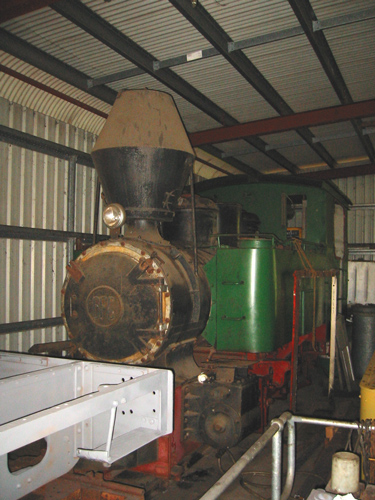|
Qunaba Mill No.4 ‘Jumbo’ Australian Sugar Cane Railway, Bundaberg |

My visit to the Australian Sugar Cane Railway on 27
December 2004 found Qunaba Mill No.4 ‘Jumbo’ in dry storage at the rear of the
Running Shed.
The loco appeared complete and generally a good candidate
for restation, but I understand it requires firebox remediation.
|
Bundaberg Foundry Engineers Ltd |
|
|
Builder’s Number & Year |
1 of 1952 |
|
Wheel Arrangement |
0-6-2T |
|
The Bundy Fowler locos The well-known manufacturer John Fowler &
Co, Leeds, UK built many steam locomotives for the Australian sugar cane
industry, where their locomotives were held in high regard. In 1935, John
Fowler & Co made a strategic decision cease manufacture of steam locomotives
in favour of internal combustion designs, leaving a market gap in the
Australian sugar industry where there was still demand for steam traction.
Stepping in to fill this gap were Australian companies Perry Engineering in
Adelaide, and Bundaberg Foundry Engineers Ltd (Bundaberg Foundry) leveraging
their established heavy engineering business serving the cane mills of
Queensland’s Burnett Region and beyond. By 1948, Bundaberg Foundry had obtained firm
orders from various mills for 8 steam locomotives based on recent John Fowler
& Co designs operating in Queensland, in particular 0-6-2T ‘Airdmillan’ (Fowler b/n 20763 of 1935), and with modernisations
such as roller-bearing axles. It seems a licence was eventually negotiated
with John Fowler & Co, but steel supply proved problematic in the
post-war years and the first loco was not completed until 1952. A single
0-4-2T version was among the 8 constructed. These antipodean Fowler cousins
became known as ‘Bundy Fowlers’ and were not only among the last steam
locomotives built in Australia, but also among the last in revenue service –
with all 8 Bundaberg-Fowler steam locomotives ultimately passing into
preservation. John Browning & Brian Webber have written
a comprehensive and well-illustrated account of the various steam and diesel
locomotives built or reconstructed by Bundaberg Foundry Engineers Limited in
‘Built by Bundaberg Foundry’ as referenced below. Rather than repeat the
information provided in that authorative work, I have sought here to provide
a brief background to the Bundy-Fowler steam locomotives and their
preservation careers. Qunaba Mill No.4 ‘Jumbo’ First-built of the 8 Bundy Fowler locos was a
0-6-2T unit, whose builder’s plate proclaimed ‘Bundaberg Fowler No.1 1952,
Built by Bundaberg Foundry’. It was ordered by Mulgrave Central Mill at
Gordonvale in far north Queensland (south of Cairns), but that mill
dieselised its loco fleet as early as 1955 and hence the Bundy Fowler loco
was sold after only 3 years of use, moving back to the Bundaberg area at
Millaquin Mill, situated near the Burnett River, where it became No.1 in
their loco fleet. In 1975 the loco moved to nearby Qunaba Mill.
(The intriguing name ‘Qunaba’ is derived from Queensland National Bank, which
owned the mill at one stage.) At Qunaba Mill it became No.5 ‘Jumbo’ on the
mill roster, being renumbered to No.4 in 1977, and remaining in service until
as late as 1980. It was then stored at Millaquin Mill for a few years. Around 1985, No.4 ‘Jumbo’ was plinthed
outside the nearby Bundaberg Rum distillery. In 2002 a change in fortunes
came when the loco was donated to the Bundaberg Steam Tramway Preservation
Society (BSTPS) in recognition of being the first steam locomotive built in
Bundaberg. No.4 ‘Jumbo’ moved to the BSTPS workshops on 1 February 2002 and
was placed in dry storage. I understand the plan was to commence restoration
works in 2019, but apparently expensive firebox work is needed. The Australian Sugar Cane Railway is located within
the Bundaberg Botanical Gardens and operated by the Bundaberg Steam Tramway
Preservation Society. I greatly enjoyed my visit there during the heat and
humidity of a Christmas holiday on 26 & 27 December 2004, receiving a
warm welcome by Society volunteers who kindly showed me around their
operation and running shed. I understand the railway loop around the Botanical
Gardens has since been extended to provide a longer journey. |

Ross Driver kindly provided this photo of No.4 ‘Jumbo’
leading No.2 ‘Skipper’ working
hard double heading a load of cane up Johnson's Hill into Qunaba Mill circa
1977.
The yellow & red livery was a feature of the Qunaba Mill
locomotives, whereas the Bundy Fowlers carried Hawthorn Green when first built.

Ross also provided this 1974 photo of No.4 ‘Jumbo’ waiting
in a loop for another cane train to pass.
Ross is driving No.4 while his younger brother is the
driver of the approaching train.
References
|
a |
Light
Railway Research Society of Australia Inc. Web site (Retrieved
3 November 2018): 'Preserved
Australian Sugar Cane Locomotives' list by John Browning |
|
b |
Website for Bundaberg Walkers
Engineering Ltd, retrieved
12 September 2022 |
|
c |
Browning J.
& Webber B. ‘Built
by Bundaberg Foundry’, published 2012 by the Australian
Narrow Gauge Railway Museum Society, Woodford QLD ISBN
978-0-9596009-4-0 |
|
d |
'Light Railways - Australia's Magazine of Industrial &
Narrow Gauge Railways', Number 164, April
2002, published by Light Railway Research Society of Australia
Inc. |
|
e |
Australian Sugar Cane Railway website (History
page), retrieved 3 August 2022 |
|
f |
Information sheet provided by the Bundaberg Steam Tramway
Preservation Society and discussions with members during my visit of 26 &
27 December 2004. |
Page updated: 11 December 2022
|
Government Railways: |
|
|||||||||
|
Private & Industrial Railways: |
|